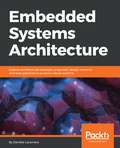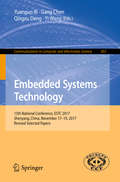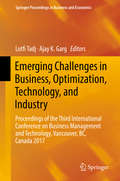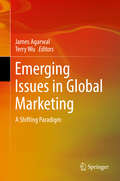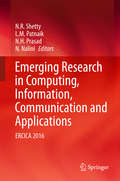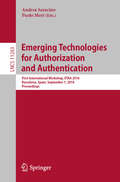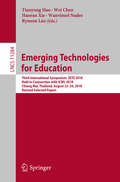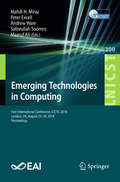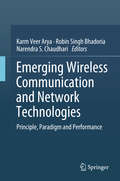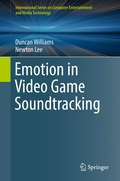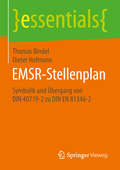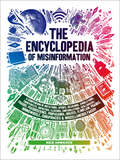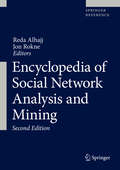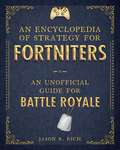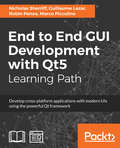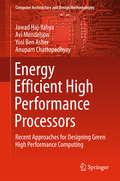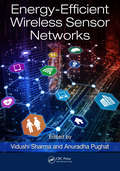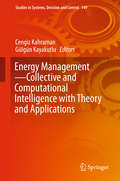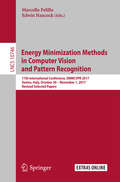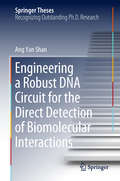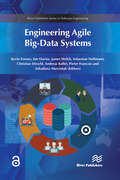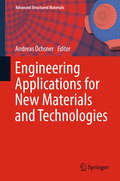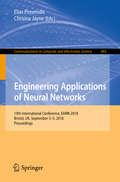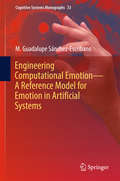- Table View
- List View
Embedded Systems Architecture: Explore architectural concepts, pragmatic design patterns, and best practices to produce robust systems
by Daniele LacameraLearn to design and develop safe and reliable embedded systemsKey FeaturesIdentify and overcome challenges in embedded environmentsUnderstand the steps required to increase the security of IoT solutionsBuild safety-critical and memory-safe parallel and distributed embedded systemsBook DescriptionEmbedded systems are self-contained devices with a dedicated purpose. We come across a variety of fields of applications for embedded systems in industries such as automotive, telecommunications, healthcare and consumer electronics, just to name a few.Embedded Systems Architecture begins with a bird's eye view of embedded development and how it differs from the other systems that you may be familiar with. You will first be guided to set up an optimal development environment, then move on to software tools and methodologies to improve the work flow. You will explore the boot-up mechanisms and the memory management strategies typical of a real-time embedded system. Through the analysis of the programming interface of the reference microcontroller, you'll look at the implementation of the features and the device drivers. Next, you'll learn about the techniques used to reduce power consumption. Then you will be introduced to the technologies, protocols and security aspects related to integrating the system into IoT solutions.By the end of the book, you will have explored various aspects of embedded architecture, including task synchronization in a multi-threading environment, and the safety models adopted by modern real-time operating systems.What you will learnParticipate in the design and definition phase of an embedded productLearn about architectural design patterns and engineering tradeoffsBuild an embedded development lab and optimize the workflowWrite memory-safe codeUnderstand the architecture behind the most communication interfacesUnderstand the design and development patterns for connected and distributed devices in the IoTMaster multitask parallel execution patterns and real-time operating systemsWho this book is forIf you’re a software developer or designer wanting to learn about embedded programming, this is the book for you. You’ll also find this book useful if you’re a less experienced embedded programmer willing to expand your knowledge.
Embedded Systems Technology: 15th National Conference, ESTC 2017, Shenyang, China, November 17-19, 2017, Revised Selected Papers (Communications in Computer and Information Science #857)
by Yuanguo Bi Gang Chen Qingxu Deng Yi WangThis book constitutes the refereed proceedings of the 15th National Conference on Embedded Systems Technology, ESTC 2017, held in Shenyang, China, in November 2017.The 18 revised full papers presented were carefully reviewed and selected from 45 papers. The topics cover a broad range of fields focusing on the theme "embedded systems and intelligent computing," such as context aware computing, scheduling, cyber physical system, high performance embedded computing, embedded system and applications, and education and surveys.
Emerging Challenges in Business, Optimization, Technology, and Industry
by Lotfi Tadj Ajay K. GargThis book presents selected papers on Business Management and Technology, focusing on recent research in Business, Optimization, Technology, and Global Issues. Organized in four broad tracks, papers examine Management Challenges in Today's Industry, especially concerning changes in customer demands; Optimization Challenges in Today's Business, looking at efficiency and effectiveness in providing goods and services at affordable prices; Innovation in Hospitality and Tourism; and Technological Challenges in the Era of Globalization. The book covers both production systems and service systems, including the growing area of Information Technology, and also looks at the quality of work life in various sectors of business. It presents a balanced blend of theoretical and practical papers.
Emerging Issues in Global Marketing: A Shifting Paradigm
by James Agarwal Terry WuThis book examines emerging theories, frameworks, and applications of global marketing for the 21st century. It highlights how global marketing is changing in a globalized and digital economy that is fast increasing in complexity and uncertainty. The traditional approach to global marketing is no longer sufficient to address the emerging issues in global markets. Global companies need to challenge traditional assumptions in global marketing in an era of shifting political, cultural, economic, and technological changes. They need to take a fresh look at the contemporary threats and opportunities in markets, institutions, and technology and how they affect entry and expansion strategies through careful re-calibration of the marketing-mix. This book offers new insights for global marketing that addresses these issues. This book should be an ideal resource to both academic scholars and reflective practitioners globally such as CEOs and chief marketing officers as well as government officials and policy makers interested in formulating strategies/policies for global marketing activities in the face of a globalized and digitized economy. This well-crafted research volume is an excellent addition to the growing literature on new trends in international marketing. The authors present the latest insight on the impact of phenomena such as cross-border e-commerce and digital markets, and they discuss new tools for political risk assessment, international branding and more broadly the reconfiguring of marketing-mix strategies – A powerful reminder that the new global market remains a rugged landscape. - Alain Verbeke, McCaig Research Chair in Management and Editor-in-Chief Journal of International Business Studies, University of Calgary, Canada. Emerging trends in institutions, markets, and societies, along with new technological advances, are redefining the scope and strategy in global marketing. Professors Agarwal and Wu have assembled a remarkable collection of cutting-edge topics and issues that capture the shifting paradigm and contemporary developments in the global marketing field. This is an informative and timely resource that makes a valuable contribution, useful for both scholars and business practitioners of global marketing. - Constantine S. Katsikeas, Arnold Ziff Endowed Research Chair in Marketing & International Management, Editor-in-Chief Journal of International Marketing, University of Leeds, UK. This book presents new and cutting-edge thinking at a time when the traditional views of international marketing need to be scrapped. Convergence forces are creating new opportunities as well as threats on a daily basis, and marketing practitioners as well as scholars must be forewarned as well as forearmed on how to deal with these changes. The real growth is coming from the emerging nations, and the theories that provided sufficient insights ten years ago have been completely outmoded by the ever-accelerating rate of innovation and technological change as well as the pressures to address the needs of all of the firm’s relevant stakeholders. The strategic insights provided here are absolutely invaluable. Don’t miss an opportunity to read this book!! - John B. Ford, Professor of Marketing & International Business, Eminent Scholar & Haislip-Rohrer Fellow, Editor-in-Chief, Journal of Advertising Research, Old Dominion University, USA.
Emerging Research in Computing, Information, Communication and Applications
by N. R. Shetty L. M. Patnaik N. H. Prasad N. NaliniThis book presents the proceedings of International Conference on Emerging Research in Computing, Information, Communication and Applications, ERCICA 2016. ERCICA provides an interdisciplinary forum for researchers, professional engineers and scientists, educators, and technologists to discuss, debate and promote research and technology in the upcoming areas of computing, information, communication and their applications. The book discusses these emerging research areas, providing a valuable resource for researchers and practicing engineers alike.
Emerging Technologies for Authorization and Authentication: First International Workshop, ETAA 2018, Barcelona, Spain, September 7, 2018, Proceedings (Lecture Notes in Computer Science #11263)
by Andrea Saracino Paolo MoriThis book constitutes the proceedings of the First International Workshop on Emerging Technologies for Authorization and Authentication, ETAA 2018, held in Barcelona, Spain, in September 2018. The 10 papers presented in this volume were carefully reviewed and selected from 16 submissions. They were organized in two parts: authentication and authorization techniques and violation detection and countermeasures.
Emerging Technologies for Education: Third International Symposium, SETE 2018, Held in Conjunction with ICWL 2018, Chiang Mai, Thailand, August 22–24, 2018, Revised Selected Papers (Lecture Notes in Computer Science #11284)
by Tianyong Hao Wei Chen Haoran Xie Wanvimol Nadee Rynson LauThis book constitutes the thoroughly refereed post-workshop proceedings of the Third International Symposium, SETE 2018, held in conjunction with ICWL 2018, Chiang Mai, Thailand, in August 2018.The 23 full and 3 short papers were carefully reviewed and selected from 51 submissions. The papers have been organized in the following topical sections: Emerging Technologies of Design, Model and Framework of Learning Systems; Emerging Technologies Support for Intelligent Tutoring; Emerging Technologies Support for Game-Based and Joyful Learning; Emerging Technologies of Pedagogical Issues; UMLL (International Symposium on User Modeling and Language Learning); ETLTL (International Workshop on Educational Technology for Language and Translation Learning)
Emerging Technologies in Computing: First International Conference, iCETiC 2018, London, UK, August 23–24, 2018, Proceedings (Lecture Notes of the Institute for Computer Sciences, Social Informatics and Telecommunications Engineering #200)
by Andrew Ware Mahdi H. Miraz Peter Excell Safeeullah Soomro Maaruf AliThis book constitutes the refereed conference proceedings of the First International Conference on Emerging Technologies in Computing, iCEtiC 2018, held in London, UK, in August 2018. The 26 revised full papers were reviewed and selected from more than 59 submissions and are organized in topical sections covering Cloud, IoT and distributed computing, software engineering, communications engineering and vehicular technology, AI, expert systems and big data analytics, Web information systems and applications, security, database system, economics and business engineering, mLearning and eLearning.
Emerging Wireless Communication and Network Technologies: Principle, Paradigm and Performance
by Karm Veer Arya Robin Singh Bhadoria Narendra S. ChaudhariThe book covers a wide range of wireless communication and network technologies, and will help readers understand the role of wireless technologies in applications touching on various spheres of human life, e.g. healthcare, agriculture, building smart cities, forecasting and the manufacturing industry.The book begins by discussing advances in wireless communication, including emerging trends and research directions for network technologies. It also highlights the importance of and need to actively develop these technologies. In turn, the book addresses different algorithms and methodologies which could be beneficial in implementing 5G Mobile Communication, Vehicular Ad-hoc Networks (VANET), Reliable Cooperative Networks, Delay Tolerant Networks (DTN) and many more contexts related to advanced communications. It then addresses the prominence of wireless communication in connection with the Internet of Things (IoT), Mobile Opportunistic Networks and Cognitive Radio Networks (CRN). Lastly, it presents the new horizons in architecture and building protocols for Li-Fi (Light-Fidelity) and Wearable Sensor Technology.
Emotion in Video Game Soundtracking
by Duncan Williams Newton LeeThis book presents an overview of the emerging field of emotion in videogame soundtracking. The emotional impact of music has been well-documented, particularly when used to enhance the impact of a multimodal experience, such as combining images with audio as found in the videogames industry. Soundtracking videogames presents a unique challenge compared to traditional composition (for example film music) in that the narrative of gameplay is non-linear – Player dependent actions can change the narrative and thus the emotional characteristics required in the soundtrack. Historical approaches to emotion measurement, and the musical feature mapping and music selection that might be used in video game soundtracking are outlined, before a series of cutting edge examples are given. These examples include algorithmic composition techniques, automated emotion matching from biosensors, motion capture techniques, emotionally-targeted speech synthesis and signal processing, and automated repurposing of existing music (for example from a players own library). The book concludes with some possibilities for the future.
EMSR-Stellenplan: Symbolik Und Übergang Von Din 40719-2 Zu Din En 81346-2 (Essentials)
by Dieter Hofmann Thomas BindelThomas Bindel und Dieter Hofmann ordnen EMSR- bzw. PCE-Stellenpläne als wichtige Unterlagen der Projektierung von Automatisierungsanlagen ein. DIN 19227-2 gilt weiterhin, jedoch wurde DIN 40719-2 zurückgezogen und durch DIN EN 81346-2 ersetzt. Da in EMSR-Stellenplänen bereits existierender Anlagen Betriebsmittel nach DIN 40719-2 gekennzeichnet wurden, stehen Anwender vor einer Herausforderung: Sie müssen diese Norm nach wie vor verstehen, für Neuanlagen in EMSR- bzw. PCE-Stellenplänen zur Referenzkennzeichnung jedoch statt DIN 40719-2 die sich eher zögerlich durchsetzende DIN EN 81346-2 anwenden. Die Autoren beleuchten die mit diesem Übergang verbundenen Änderungen und geben so Orientierung zur Nutzung von DIN EN 81346 für das Fachgebiet der Projektierung von Automatisierungsanlagen.Die AutorenProf. Dr.-Ing. Thomas Bindel lehrt Automatisierungstechnik an der Fakultät Elektrotechnik der Hochschule für Technik und Wirtschaft Dresden. Priv.-Doz. Dr.-Ing. Dieter Hofmann lehrte und lehrt Prozessautomatisierung an der TU Dresden sowie an der Staatlichen Studienakademie Bautzen.
The Enchanted Creeper (Creeper Diaries #7)
by Greyson Mann Amanda BrackGerald is falling behind in his toughest class yet—Enchantment. The homework! The quizzes! The stack of books! It all seems so unfair. But when Gerald discovers a way that enchantments might help him win the science fair, class gets a whole lot more interesting. And that Efficiency Enchantment? Well, that could sure come in handy when it's time to get homework done. Pretty soon, Gerald isn't dreading Enchantment Class—he's acing it. But his new skills could get him into a whole lot of trouble . . .
The Encyclopedia of Misinformation: A Compendium of Imitations, Spoofs, Delusions, Simulations, Counterfeits, Impostors, Illusions, Confabulations, Skullduggery, ... Conspiracies & Miscellaneous Fakery
by Rex Sorgatz“In an era of ‘alternative facts,’ Rex Sorgatz’s The Encyclopedia of Misinformation helps put things in perspective.” —Fast CompanyThis compendium of misinformation, deception, and self-delusion throughout history examines fakery in the context of science and advertising, humor and law, sports and video games, and beyond. Entries span eclectic topics: Artificial Intelligence, Auto-Tune, Chilean Sea Bass, Clickbait, Cognitive Dissonance, Cryptids, False Flag Operations, Gaslighting, Gerrymandering, Kayfabe, Laugh Tracks, Milli Vanilli, P.T. Barnum, Photoshopping, Potemkin Villages, Ponzi Schemes, Rachel Dolezal, Strategery, Truthiness, and the Uncanny Valley. From A to Z, this is the definitive guide to how we are tricked, and how we trick ourselves.“Occasional salty language and pop-culture references make this compendium of 300 short entries a delightful mix of high- and lowbrow.” —Booklist
Encyclopedia of Social Network Analysis and Mining
by Reda Alhajj Jon RokneSocial Network Analysis and Mining Encyclopedia (ESNAM) is the first major reference work to integrate fundamental concepts and research directions in the areas of social networks and applications to data mining. The second edition of ESNAM is a truly outstanding reference appealing to researchers, practitioners, instructors and students (both undergraduate and graduate), as well as the general public. This updated reference integrates all basics concepts and research efforts under one umbrella. Coverage has been expanded to include new emerging topics such as crowdsourcing, opinion mining, and sentiment analysis. Revised content of existing material keeps the encyclopedia current. The second edition is intended for college students as well as public and academic libraries. It is anticipated to continue to stimulate more awareness of social network applications and research efforts.The advent of electronic communication, and in particular on-line communities, have created social networks of hitherto unimaginable sizes. Reflecting the interdisciplinary nature of this unique field, the essential contributions of diverse disciplines, from computer science, mathematics, and statistics to sociology and behavioral science, are described among the 300 authoritative yet highly readable entries. Students will find a world of information and insight behind the familiar façade of the social networks in which they participate. Researchers and practitioners will benefit from a comprehensive perspective on the methodologies for analysis of constructed networks, and the data mining and machine learning techniques that have proved attractive for sophisticated knowledge discovery in complex applications. Also addressed is the application of social network methodologies to other domains, such as web networks and biological networks.
An Encyclopedia of Strategy for Fortniters: An Unofficial Guide for Battle Royale (Encyclopedia for Fortniters #1)
by Jason R. RichThe Ultimate Unofficial Encyclopedia for Fortniters is a full-color, easy-to-read, unofficial reference tool that explains—from “A” to “Z”—everything players need to know in order to consistently win matches and successfully control their characters. <P><P>The Ultimate Unofficial Encyclopedia for Fortniters provides a comprehensive overview of the game—making it easier for first-time players to quickly get acclimated with the game—while, at the same time, it introduces more experienced players to countless advanced tips and strategies that will allow them to quickly improve their skills and survival rates. The tips and strategies included are related to safe exploration, creative building, offensive and defensive fighting techniques, and cunning survival skills. <P><P>Each of the more than one hundred topics covered within The Ultimate Unofficial Encyclopedia for Fortniters includes a detailed description, full-color screenshots, and appropriate tips and strategies that apply to the current and future versions of the game. This book is a must-read guide and information-packed resource for every Fortnite: Battle Royale player.
End to End GUI Development with Qt5: Develop cross-platform applications with modern UIs using the powerful Qt framework
by Nicholas Sherriff Guillaume Lazar Robin Penea Marco PiccolinoLearn the complete Qt ecosystem and its tools and build UIs for mobile and desktop applicationsKey FeaturesUnleash the power of the latest Qt 5.9 with C++14Easily compile, run, and debug your applications from the powerful Qt Creator IDEBuild multi-platform projects that target Android, iOS, Windows, MacOS, Linux, and moreBook DescriptionQt 5.9 is an application development framework that provides a great user experience and develops full-capability applications with Qt Widgets, QML, and even Qt 3D. This learning path demonstrates the power and flexibility of the Qt framework for desktop application development and shows how you can write an application once and deploy it to multiple operating systems. It will address all the challenges while developing cross-platform applications with the Qt framework.This course will give you a better understanding of the Qt framework and tools to resolve serious issues such as linking, debugging, and multithreading. It will also upskill you by explaining how to create a to-do-style app and taking you through all the stages in building a successful project. You will build a suite of apps; while developing these apps, you’ll deepen your knowledge of Qt Quick's layout systems, and see Qt 3D and widgets in action. The next project will be in the industrial and agricultural sectors: making sense of sensor data via a monitoring system. Your apps should run seamlessly across devices and operating systems such as Android, iOS, Windows, or Mac, and be cost-effective by integrating with existing web technologies. You take the role of lead developer and prototype a monitoring system. In doing so, you’ll get to know Qt's Bluetooth and HTTP APIs, as well as the Charts and Web Engine UI modules. These projects will help you gain a holistic view of the Qt framework.What you will learnInstall and configure the Qt Framework and Qt Creator IDEImplement a rich user interface with QMLLearn the fundamentals of QtTest and how to integrate unit testingCreate stunning UIs with Qt Widget and Qt QuickDevelop powerful, cross-platform applications with the Qt frameworkDesign GUIs with Qt Designer and build a library in it for UI previewsBuild a desktop UI with widgets and DesignerGet familiar with multimedia components to handle visual input and outputWho this book is forThis book will appeal to developers and programmers who would like to build GUI-based applications. Knowledge of C++ is necessary and a basic familiarity with Qt would be helpful.
Energy Efficient High Performance Processors: Recent Approaches For Designing Green High Performance Computing (Computer Architecture and Design Methodologies)
by Jawad Haj-Yahya Avi Mendelson Yosi Ben Asher Anupam ChattopadhyayThis book explores energy efficiency techniques for high-performance computing (HPC) systems using power-management methods. Adopting a step-by-step approach, it describes power-management flows, algorithms and mechanism that are employed in modern processors such as Intel Sandy Bridge, Haswell, Skylake and other architectures (e.g. ARM). Further, it includes practical examples and recent studies demonstrating how modem processors dynamically manage wide power ranges, from a few milliwatts in the lowest idle power state, to tens of watts in turbo state. Moreover, the book explains how thermal and power deliveries are managed in the context this huge power range. The book also discusses the different metrics for energy efficiency, presents several methods and applications of the power and energy estimation, and shows how by using innovative power estimation methods and new algorithms modern processors are able to optimize metrics such as power, energy, and performance. Different power estimation tools are presented, including tools that break down the power consumption of modern processors at sub-processor core/thread granularity. The book also investigates software, firmware and hardware coordination methods of reducing power consumption, for example a compiler-assisted power management method to overcome power excursions. Lastly, it examines firmware algorithms for dynamic cache resizing and dynamic voltage and frequency scaling (DVFS) for memory sub-systems.
Energy-Efficient Wireless Sensor Networks
by Vidushi Sharma Anuradha PughatThe advances in low-power electronic devices integrated with wireless communication capabilities are one of recent areas of research in the field of Wireless Sensor Networks (WSNs). One of the major challenges in WSNs is uniform and least energy dissipation while increasing the lifetime of the network. This is the first book that introduces the energy efficient wireless sensor network techniques and protocols. The text covers the theoretical as well as the practical requirements to conduct and trigger new experiments and project ideas. The advanced techniques will help in industrial problem solving for energy-hungry wireless sensor network applications.
Energy Management—Collective and Computational Intelligence with Theory and Applications: Collective And Computational Intelligence With Theory And Applications (Studies In Systems, Decision And Control #149)
by Cengiz Kahraman Gülgün KayakutluThis book presents a selection of recently developed collective and computational intelligence techniques, which it subsequently applies to energy management problems ranging from performance analysis to economic analysis, and from strategic analysis to operational analysis, with didactic numerical examples. As a form of intelligence emerging from the collaboration and competition of individuals, collective and computational intelligence addresses new methodological, theoretical, and practical aspects of complex energy management problems. The book offers an excellent reference guide for practitioners, researchers, lecturers and postgraduate students pursuing research on intelligence in energy management. The contributing authors are recognized researchers in the energy research field.
Energy Minimization Methods in Computer Vision and Pattern Recognition: Second International Workshop, Emmcvpr'99, York, Uk, July 26-29, 1999, Proceedings (Lecture Notes in Computer Science #1654)
by Marcello Pelillo Edwin HancockThis volume constitutes the refereed proceedings of the 11th International Conference on Energy Minimization Methods in Computer Vision and Pattern Recognition, EMMCVPR 2017, held in Venice, Italy, in October/November 2017. The 37 revised full papers were carefully reviewed and selected from 51 submissions. The papers are organized in topical sections on Clustering and Quantum Methods; Motion and Tracking; Image Processing and Segmentation; Color, Shading and Reflectance of Light; Propagation and Time-evolution; and Inference, Labeling, and Relaxation.
Engineering a Robust DNA Circuit for the Direct Detection of Biomolecular Interactions (Springer Theses)
by Ang Yan ShanThis book provides essential insights into designing a localized DNA circuit to promote the rate of desired hybridization reactions over undesired leak reactions in the bulk solution. The area of dynamic DNA nanotechnology, or DNA circuits, holds great promise as a highly programmable toolbox that can be used in various applications, including molecular computing and biomolecular detection. However, a key bottleneck is the recurring issue of circuit leakage. The assembly of the localized circuit is dynamically driven by the recognition of biomolecules – a different approach from most methods, which are based on a static DNA origami assembly. The design guidelines for individual reaction modules presented here, which focus on minimizing circuit leakage, are established through NUPACK simulation and tested experimentally – which will be useful for researchers interested in adapting the concepts for other contexts. In the closing section, the design concepts are successfully applied to the biomolecular sensing of a broad range of targets including the single nucleotide mutations, proteins, and cell surface receptors.
Engineering Agile Big-Data Systems (River Publishers Series In Software Engineering Ser.)
by Kevin Feeney Jim Davies James WelchTo be effective, data-intensive systems require extensive ongoing customisation to reflect changing user requirements, organisational policies, and the structure and interpretation of the data they hold. Manual customisation is expensive, time-consuming, and error-prone. In large complex systems, the value of the data can be such that exhaustive testing is necessary before any new feature can be added to the existing design. In most cases, the precise details of requirements, policies and data will change during the lifetime of the system, forcing a choice between expensive modification and continued operation with an inefficient design.Engineering Agile Big-Data Systems outlines an approach to dealing with these problems in software and data engineering, describing a methodology for aligning these processes throughout product lifecycles. It discusses tools which can be used to achieve these goals, and, in a number of case studies, shows how the tools and methodology have been used to improve a variety of academic and business systems.
Engineering Applications for New Materials and Technologies (Advanced Structured Materials #85)
by Andreas ÖchsnerThis book discusses the expertise, skills, and techniques needed for the development of new materials and technologies. It focuses on finite element and finite volume methods that are used for engineering simulations, and present many state-of-the-art applications and advances to highlight these methods’ importance. For example, modern joining technologies can be used to fabricate new compound or composite materials, even those formed from dissimilar component materials. These composite materials are often exposed to harsh environments, must deliver specific characteristics, and are primarily used in automotive and marine technologies, i.e., ships, amphibious vehicles, docks, offshore structures, and even robots. To achieve the desired material performance, computer-based engineering tools are widely used for simulation, data evaluation, and design processes.
Engineering Applications of Neural Networks: 19th International Conference, EANN 2018, Bristol, UK, September 3-5, 2018, Proceedings (Communications in Computer and Information Science #893)
by Elias Pimenidis Chrisina JayneThis book constitutes the refereed proceedings of the 19th International Conference on Engineering Applications of Neural Networks, EANN 2018, held in Bristol, UK, in September 2018.The 16 revised full papers and 5 revised short papers presented were carefully reviewed and selected from 39 submissions. The papers are organized in topical sections on activity recognition, deep learning, extreme learning machine, machine learning applications, predictive models, fuzzy and recommender systems, recurrent neural networks, spiking neural networks.
Engineering Computational Emotion - A Reference Model for Emotion in Artificial Systems
by M. Guadalupe Sánchez-EscribanoThis book provides a new perspective on emotion in artificial systems. It presents an insightful explanation of how emotion might emerge deep inside the systems, and emotional behaviour could be seen as a consequence of their internal management. The final approach attempts to account for a range of events associated with emotion, from functional and behavioural features to aspects related to the dynamics and the development of feeling. The book provides a theoretical foundation for engineering and designing computational emotion as a framework for developing future adaptive systems. It includes a painstaking analysis of the rationales for the features of the final approach, including aspects from the fields of Artificial Intelligence, Psychology, the Cognitive Sciences and Model-based Systems. Synthesizing knowledge from a variety of disciplines, it ultimately presents a model conceptualization following the perspectives of Engineering and the Cognitive Sciences.
